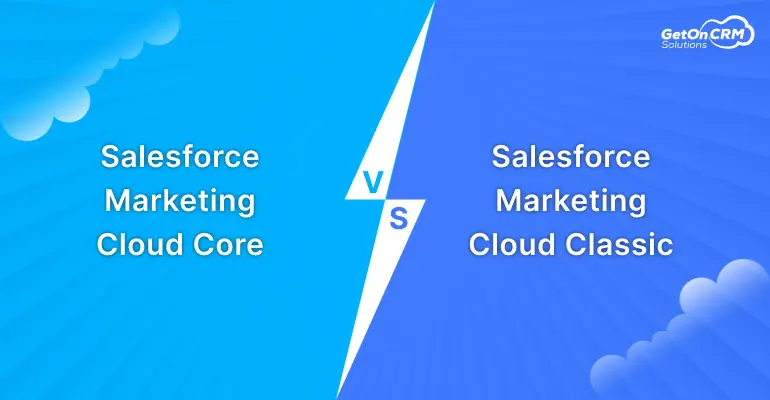Marketing just got smarter. Salesforce Marketing Cloud Core puts your marketing directly inside the Salesforce ecosystem, turning every customer interaction into a data-driven opportunity. Teams can now access the same CRM data, automation workflows, and analytics tools they already trust—no extra connectors, no messy integrations. The payoff? Faster campaigns, deeper personalization, and seamless collaboration across sales, service, and marketing teams. For businesses already running Salesforce, this is the missing piece to unlock the full potential of their CRM investments.
80% of SMBs using AI in their salesforce. workflows reported revenue growth . That’s not just tech hype—that’s real-world impact showing why integrated marketing is more than an upgrade; it’s a strategic growth engine.
As organizations look to unify their marketing solutions with their Salesforce CRM, moving to Marketing Cloud Core is the smarter, long-term play. It’s where automation meets intelligence, and where marketing becomes fully native, embedded, and unstoppable.
Why This Evolution Matters
For years, marketing teams have had to switch between different tools for campaigns, CRM, and reporting. This juggling act disrupts workflows, causes delays, and makes the customer experience less seamless. Every interaction with a customer today can make a difference. Today, every single customer interaction can tip the scales. To win, brands need a marketing stack and CRM that share the same data and languages. That’s exactly what salesforce marketing cloud delivers.
That’s where Salesforce Marketing Cloud Core takes the stage—not as another feature bump, but as a game-changing realignment. Because it’s crafted straight on the Salesforce platform, marketing, sales, and service link arms on a single backbone. Picture sparking a nurture journey from a sales lead, grabbing live customer clues while the send is humming, then sliding service notes straight into audience lists—all from the same screen, no system swaps required.
This is more than smart linking. It’s smart orchestration running at the speed and scale you need. Thanks to Salesforce’s integration backbone, your customers’ experience stays seamless and your teams stay in sync.
From Standalone to Native: Understanding SFMC Core
The legacy Salesforce Marketing Cloud—no doubt a heavy hitter—used to play the role of guest in the Salesforce house. It sat outside your main CRM, leaned on connectors, and made you jump through hoops to merge customer records. Even within the world’s number-one CRM, marketers could still feel the silo.
Now the game has changed: Marketing Cloud is remade on Salesforce Core. It’s no longer a bolt-on; it’s a true Salesforce app, the same family as salesforce sales cloud and Service Cloud. Marketing teams can now operate from a single org, diving straight into CRM records, live audiences, reporting, and journey design—all without a single extra connector line.
This change cuts down on integration headaches, gives you a friendlier interface, and connects real-time marketing automation straight to your living CRM data. If you’re figuring out how to transition from classic Marketing Cloud to SFMC Core, or if you’re looking for Salesforce Marketing Cloud experts to smooth the ride, now is the time to solidify your marketing technology for the future.
Comparison Table: Classic SFMC vs. Salesforce Marketing Cloud Core
| Feature | Classic SFMC | SFMC Core (Built on Salesforce Core) |
|---|---|---|
| Platform Base | Standalone platform | Native to Salesforce Core |
| Data Model | Separate data extensions | Uses Salesforce standard/custom objects; integrates with Data Cloud |
| Integration with CRM | API-based or connector-based | Natively embedded within Salesforce CRM |
| AI Capabilities | Limited Einstein access | Einstein 1 Studio with generative AI (some features in pilot/licensed) |
| Automation | Custom scripting, limited reuse | Unified automation with Salesforce Flow |
| Security & Compliance | Standalone security protocols | Inherits Salesforce security standards |
| Reporting & Analytics | Basic campaign reporting | Unified analytics across clouds; deeper with CRM Analytics/Data Cloud |
| Migration Complexity | Complex, manual processes | Consultant-supported; still requires planning and manual steps |
| Best For | Legacy users, siloed teams | Growth-focused businesses using the Salesforce ecosystem |
What’s New in SFMC Core?
Salesforce Marketing Cloud Core is changing how marketing teams build, manage, and scale campaigns across the Salesforce ecosystem. Built natively on Salesforce Core infrastructure, this new version creates tighter alignment between marketing, sales, and service—powered by a unified data model and AI-ready tools. For businesses focused on advancing business with marketing cloud, SFMC Core delivers a seamless, intelligent, and connected experience.

Here’s what stands out in the new SFMC Core experience and how it improves over the classic version.
➥ Journey Builder + Flow Integration
SFMC Core introduces native integration with Salesforce Flow, unifying marketing automation with core CRM logic.
Marketers can now use the familiar Flow UI to create automations that work seamlessly across Sales Cloud, Service Cloud, and Marketing Cloud.
Benefit: Consistent automation behavior across every department without needing separate tools.
➥ Unified CMS (Salesforce CMS)
SFMC Core uses a centralized CMS, allowing digital assets to be created once and reused across:
- Marketing Cloud emails and landing pages
- Experience Cloud websites or portals
This reduces silos, improves branding consistency, and accelerates asset deployment across teams.
Example:
Upload a product image to Salesforce CMS → Use it in both a marketing email and a service portal update.
➥ Built-in Einstein AI (On Einstein 1 Platform)
SFMC Core runs on Einstein 1, enabling AI features natively within campaign flows.
Key additions:
- Content generation using natural language prompts
- Predictive segmentation and send-time optimization
- Automated subject line suggestions
Benefits: Less manual work, more personalization, faster go-to-market execution.
➥ Unified Data Model with CDP Capabilities
SFMC Core supports integration with Salesforce Data Cloud (formerly CDP).
Data Cloud requires a separate license, not bundled with Growth or Advanced editions.
Once licensed, marketers can build real-time audience segments using data from Sales Cloud, Commerce Cloud, and external sources.
Enables unified profiles and cross-cloud personalization at scale.
➥ Simplified Migration & Native Core Compatibility
Moving from classic MC to SFMC Core is now smoother with:
- Migration tools
- Pre-built connectors
- Backwards compatibility
This ensures legacy marketing teams can adopt Core without losing past work or workflows.
Salesforce Marketing Cloud Core Benefits Across Industries
Salesforce Marketing Cloud Core offers industry-specific advantages by combining native marketing automation in Salesforce CRM with deeper personalization and compliance.
For Financial Services, it enables faster campaign deployment and tailored messaging, thanks to Salesforce integration services and embedded compliance tools.
For Retail/e-commerce, businesses can build omnichannel journeys and deliver personalized product recommendations using advanced Salesforce marketing automation tools.
For Healthcare, the platform supports HIPAA-ready communications and patient outreach through secure, compliant journeys, empowered by Salesforce Service Cloud implementation.
Marketing Cloud is built on Salesforce Core, making it scalable for future innovations across sectors with the support of experienced Salesforce Marketing Cloud consultants.
What Happens to Current SFMC – Salesforce Marketing Cloud Users?
Salesforce Marketing Cloud Classic will continue to operate for the time being, but SFMC Core is now the default for Growth and Advanced editions. Current users need not worry—there won’t be any sudden shutdowns—but it’s advisable to start planning your transition.
Marketing Cloud is now built on Salesforce Core for better integration and greater scalability. To transition smoothly from Classic MC to SFMC Core, consult recognized Salesforce Marketing Cloud experts or use Salesforce integration services. They can guide you step-by-step, helping you shift to the new platform without interrupting your daily workflows.
Tips for Moving and Setting Up Salesforce Marketing Cloud Core
If you’re new to Salesforce Marketing Cloud Core or an existing user looking to increase your automation capabilities, switching is a smart move. Core works in a shared Salesforce org, which makes it easier and faster to set up and access data.

To get started, do this:
In your Salesforce organization, turn on Core.
Assign the right roles and permissions to users
Use data from your current CRM to map out customer journeys.
This upgrade makes sure that your CRM data and marketing campaigns work together, whether you hire Salesforce Marketing Cloud consultants or do it yourself. Salesforce integration services make it possible for businesses to run campaigns, analytics, and automation all from one place. This makes Salesforce CRM and Service Cloud even better.
How does it affect the alignment of Sales Cloud and Marketing
Salesforce Marketing Cloud Core puts real-time customer data at the center of every interaction, which helps Sales Cloud and Marketing teams work together better.
Five Important Outcomes which align to Sales Cloud and Marketing
A single customer profile that both the Sales and Marketing teams can use
Salesforce integration services that make it easy to follow up with leads
Marketing automation tools that come with the software make it easier to start campaigns more quickly.
Better tracking of conversions right in Salesforce CRM
It’s easier to switch from Classic Marketing Cloud. Check out the guide for more information.
Get help from Salesforce Marketing Cloud consultants to make it easier to set up your CRM and add marketing tools right away.
Why Businesses Should Pay Attention
You can’t ignore the move to Salesforce Marketing Cloud Core. This platform is what makes marketing automation possible in Salesforce CRM. When data and marketing tasks are all in one place, teams get better data security, AI-powered insights, and campaigns that go live faster.
This version is built right on top of Salesforce Core and offers shared analytics and cross-cloud automation, which sets a new standard for integration services. Whether you’re using Salesforce Financial Services Cloud, Sales Cloud, or Service Cloud, or Marketing Cloud on Salesforce Core ensures seamless, connected experiences across the board. It’s more than just an upgrade—it’s a key strategic advantage.
Why SFMC Core is the Right Move for Modern Marketing
Supercharge Your Marketing with Salesforce Marketing Cloud Core
Harness the full potential of Salesforce Marketing Cloud features and native marketing automation in Salesforce CRM to deliver AI-powered, personalized campaigns. Upgrade from legacy tools or explore the best way to migrate to SFMC Core from legacy systems with expert Salesforce Marketing Cloud consultants. Streamline workflows, integrate seamlessly with your CRM, and accelerate campaign execution.
Frequently Asked Questions About Salesforce Marketing Cloud Core
What is Salesforce Marketing Cloud Core?
It’s the updated version of Marketing Cloud built natively on the Salesforce Core platform for better integration and automation.
How is SFMC Core different from Classic SFMC?
SFMC Core offers native CRM integration, shared data models, and AI-powered features, unlike the standalone Classic version.
Do I need to migrate from Classic to Core?
Yes, for better scalability, analytics, and security, migration is strongly recommended.
Is SFMC Core more secure?
Yes, it leverages Salesforce’s enterprise-grade security and compliance features.
Can I automate cross-cloud campaigns in SFMC Core?
Absolutely. SFMC Core enables seamless automation across Marketing, Sales, and Service Clouds.
Who can help with the migration to SFMC Core?
Salesforce Marketing Cloud consultants or integration experts can guide your transition efficiently.



















